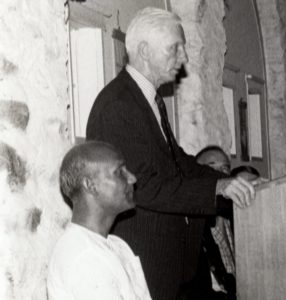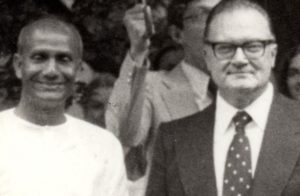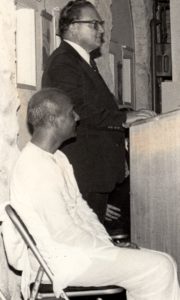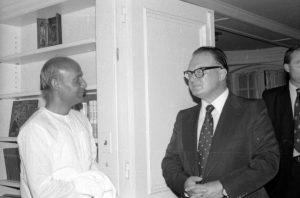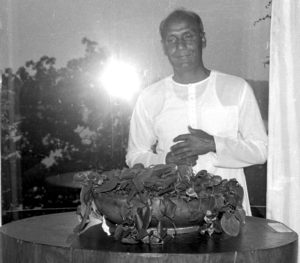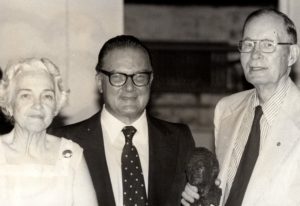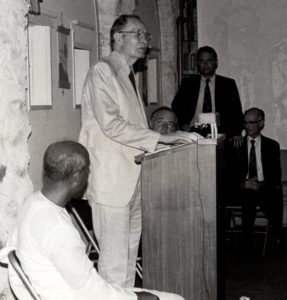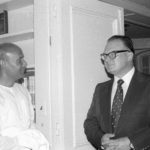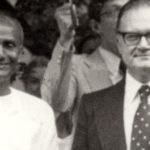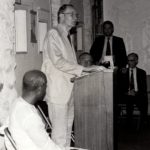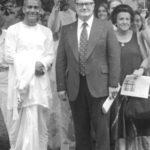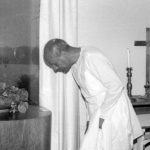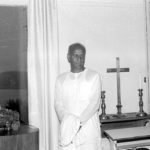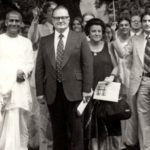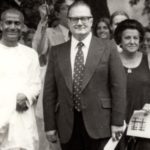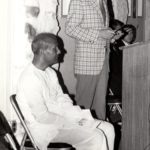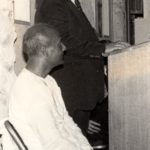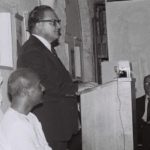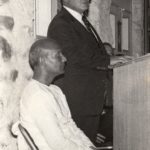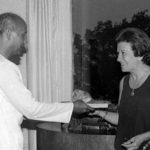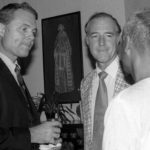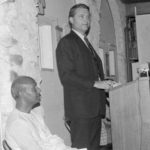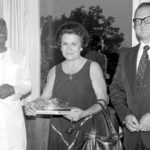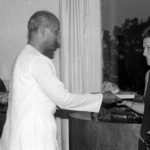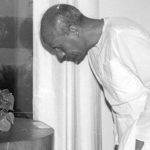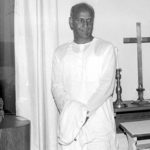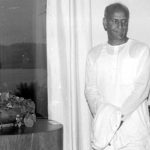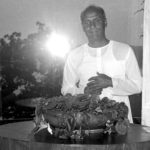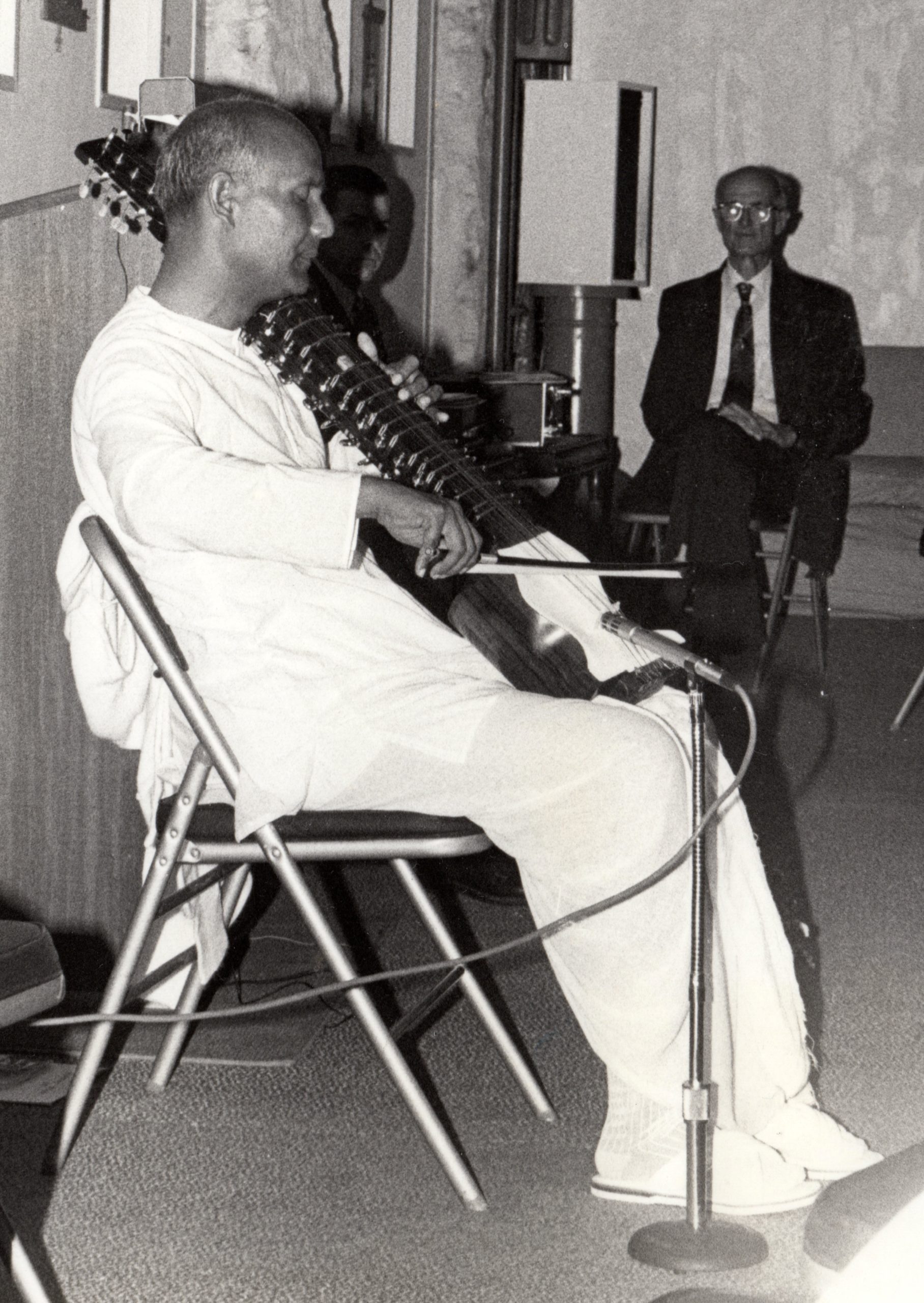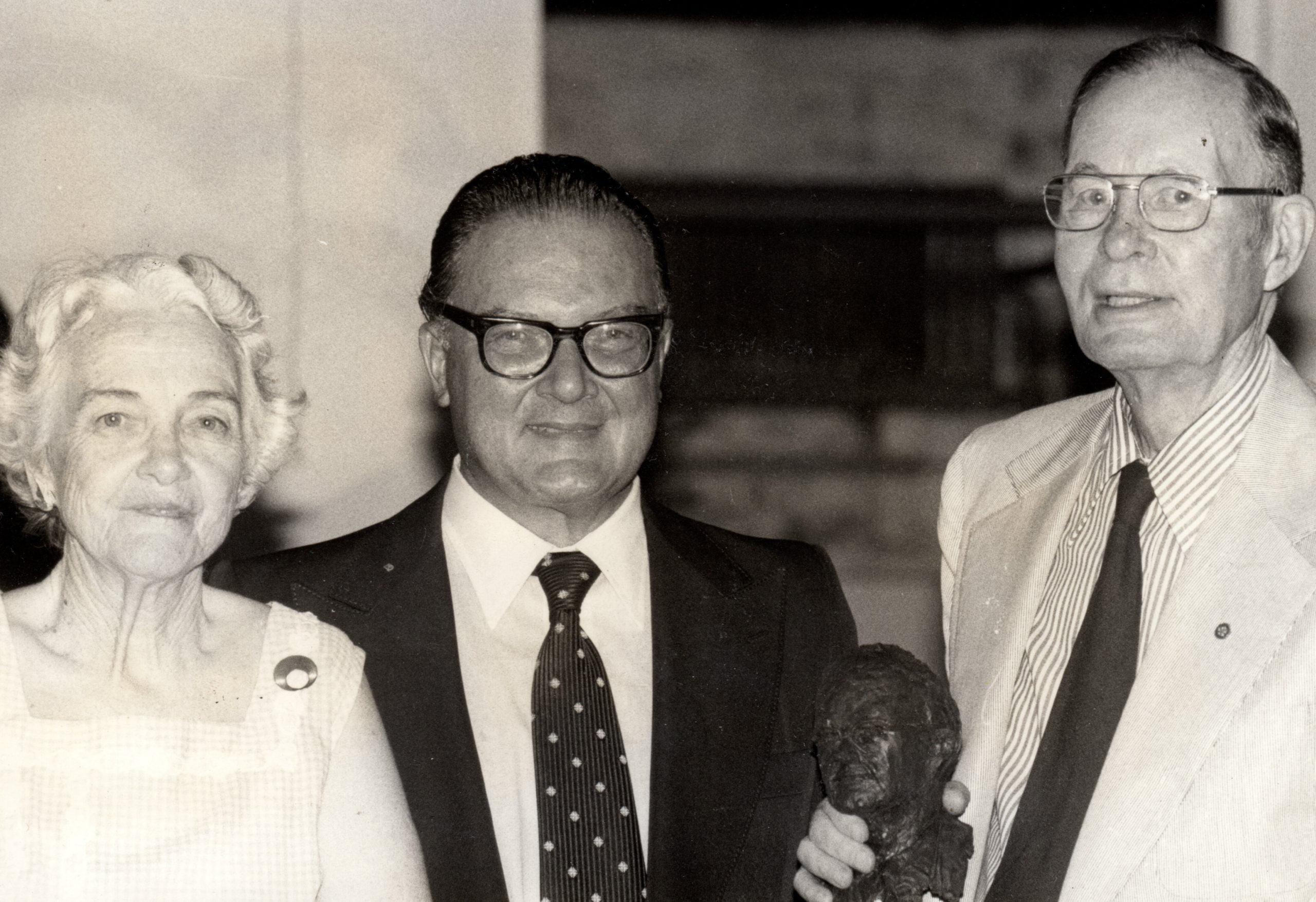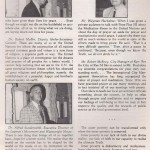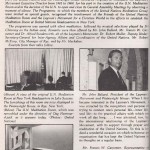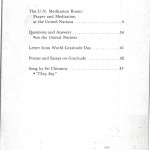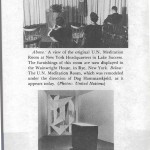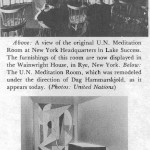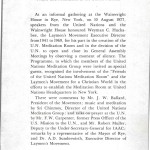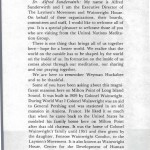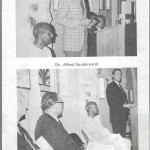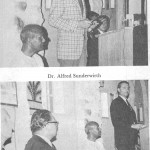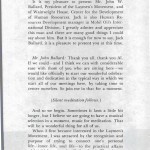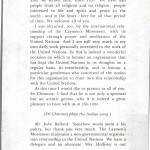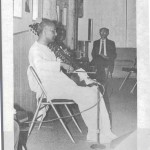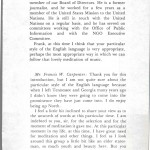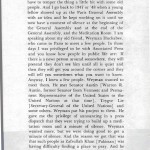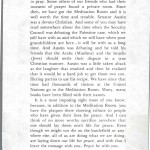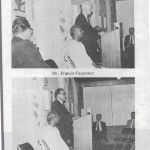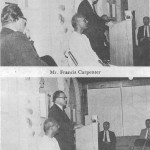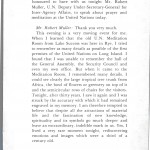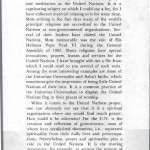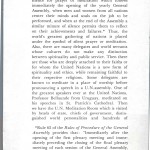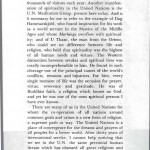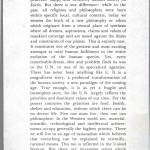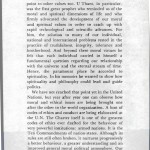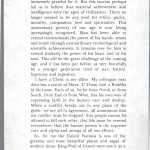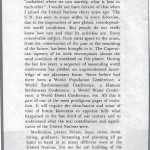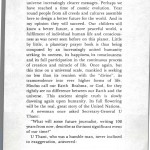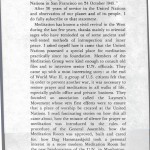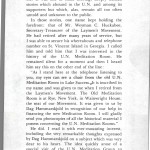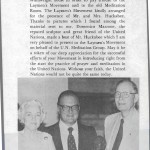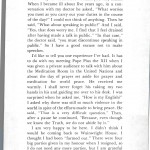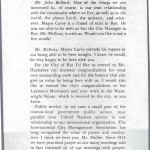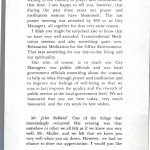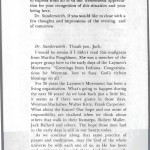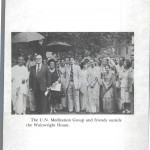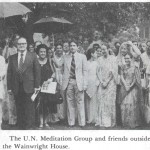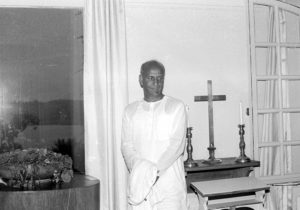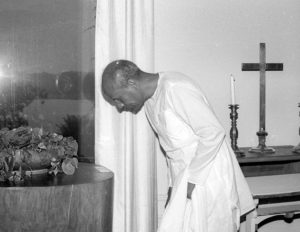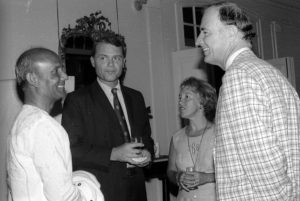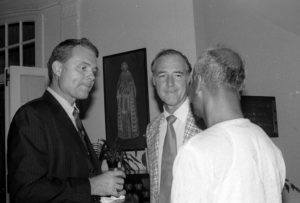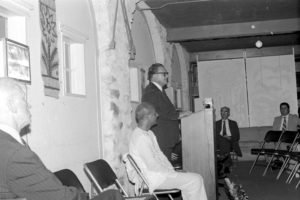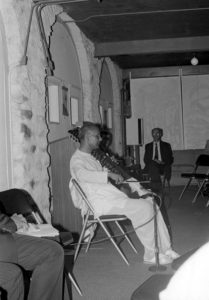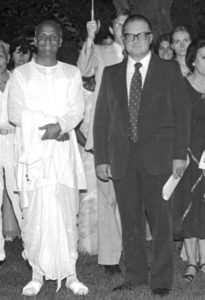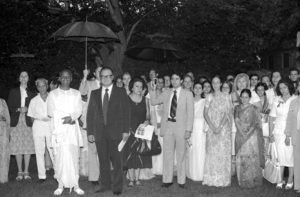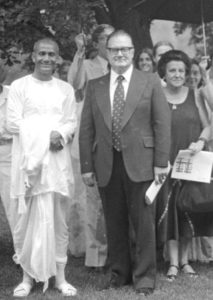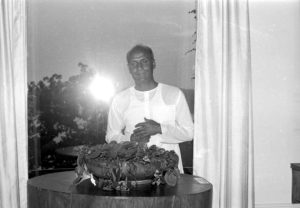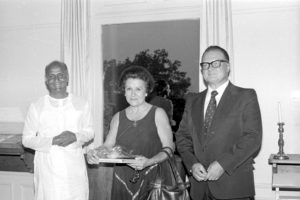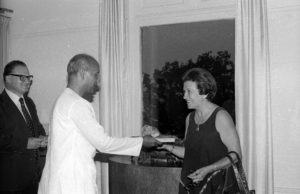C. Extended remarks from 10 Aug 1977 – more history on UN Meditation Room
Filed under Room of Quiet | Significant events & meetingsList of Details for:
- Mr. Francis W. Carpenter
- Dr. Robert Muller
- Presentation of Sculpture on behalf of Meditation Group
- Mr. Weyman Huckabee
Links to main programme and related photos are also at the bottom of this page/post.
================================================
C. Extended remarks from 10 Aug 1977
Mr. Francis W. Carpenter:
At this particular moment in my life, at this time , I have great need for meditation and other things. I feel as I look around this group a little bit like an elder states man, so much youth and beauty here. But you have to temper the thing a little bit with some old people. And I go back to 1947 or ’48 when a young fellow showed up at the Paris General Assembly with an idea and he kept working on it until we now have a moment of silence at the beginning of the General Assembly and at the end of the General Assembly, and the Meditation Room. I am speaking about my oId friend, Weyman Huckabee, who came to Paris to meet a few people. In those days I was privileged to be with Associated Press and you know how people in public life are: If there is a news person around somewhere, they will pretend they don’t see him until all is quiet and then they will get you around the corner and they will tell you sometimes what you want to know. Anyway, I knew a few people. Weyman wanted to meet them. He met Senator Austin [Warren R. Austin, former Senator from Vermont and Permanent Representative of the United States to the United Nations at that time] , Trygve Lie [Secretary-General of the United Nations] and some others. Weyman put his project to them. He gave me the privilege of announcing in a press dispatch that they were trying to build up a meditation room and a minute of silence. Weyman wanted more, but we were doing good to get a minute of silence. And the reason we got that was that such people as Zafrullah Khan [Pakistan] was having difficulty finding a place to pray. And he was known sometimes to go to the telephone booth and face East which was the best way he could find to pray. Some others of our friends who had their moment of prayer found a private room. Since then, we have got the Meditation Room and it is well worth the time and trouble. Senator Austin was a devout Christian. And some of you may have’ read somewhere about the time when the Security Council was debating the Palestine case, which we still have with us and which we will have when your grandchildren are here – it will be with us a long time. And Austin was debating and he told his friends that the Arabs (Muslims) and the Israelis (Jews) should settle their dispute in a true Christian manner. Austin was ‘a little taken aback at the laughter that resulted and then he realised that it would be a hard job to get those two conflicting parties to use his recipe. We have since that time had thousands of visitors at the United Nations go to the Meditation Room. Many, many books have been filled with their names. It is a most imposing sight most of you know, because, in addition to the Meditation Room, you have the plaques there showing tribute to people who have given their lives for peace. And I can think of no more worthy sacrifice anywhere that one should lay down one’s life for peace. Even though we might not die on the battlefield or anywhere else, all of us are doing what we are doing, are laying down our life for peace, and with that I leave the message with you. Peace be with you.
Mr . Robert Muller:
This evening is a very moving event for me. When I learned that the old U.N. Meditation Room from Lake Success was here in Rye , I tried to remember as many details as possible of the first premises of th e United Nations on Long Island . I found that I was unable to remember the hall of the General Assembly, the Security Council and even my own office . But when it came to the Meditation Room, I remembered many details. I could see clearly the large tropical tree trunk from Africa, the bowl of flowers or greenery on top of it and the semicircular rows of chairs for the visitors.
Tonight, after thirty years, I saw it again and I was struck by the accuracy with which it had remained engraved in my memory. I am therefore tempted to believe that despite all the attractions of material life and the fascination of new knowledge, spirituality and its symbols go much deeper and leave an extraordinary, indelible ma rk in us. Yes, I lived a very rare moment tonight, rediscovering emotions and images which were a third of a century old.
You asked me to say a few words about prayer and meditation at the United Nations. It is a captivating subject on which I could say a lot, for I have collected material relating to it for some time. Most striking is the fact that many of the world’s principal religions are accredited to the United Nations as non-governmental organizations. Several of their leaders have visited the United Nations. Most memorable was the visit of His Holiness Pope Paul VI during the General Assembly of 1965. Many religions have special invocations, prayers, hymns and services for the United Nations. I have brought with me a file from which I could read to you several of such texts. Among the most interesting examples are those of the Unitarian-Universalist and Baha’i faiths, which sometimes give the impression of being little United Nations of their own. It is a common practice of the Unitarian-Universalists to display the United Nations flag in their places of worship. When it comes to the United Nations proper, one can obviously not say that it is a spiritual organization where one would find much prayer. How could it be otherwise? For the U.N. is the creation and reflection of governments, most of whom have secularized themselves, i.e., separated spirituality from ·their daily lives and preoccupations.
Nevertheless, prayer and spirituality play a role in the United Nations. It is the moving experience, for example, to witness the minute of silence for prayer or meditation which follows immediately the opening of the yearly General Assembly, when men and women from all nations center their minds and souls on the job to be performed, and when at the end of the Assembly a similar minute of silence permits them to reflect on their achievements and failures. * Thus, the world’s greatest gathering of nations is placed under the symbol of silent prayer or meditation.
=================Note n Rule 62 ======================
*Rule 62 of the Rules of Procedure of the General Assembly provides that: “Immediately after the opening of the first plenary meeting and immediately preceding the dosing of the final plenary meeting of each session of the General Assembly, the President shall invite the representatives to observe one minute of silence dedicated to prayer or meditation.”
=============================================
Also, there are many delegates and world servants whose cultures do not make any distinction between spirituality and public service. Then there are those who are deeply attached to their faiths or for whom the United Nations is a new form of spirituality and ethics, while remaining faithful to their respective religions. Some delegates are known to meditate in a place of worship before pronouncing a speech in a U.N. Assembly. One of the greatest speakers ever at the United Nations, Professor Bellaunde from Uruguay, meditated on his speeches in St. Patrick’s Cathedral. Then we have the U.N. Meditation Room which is visited by heads of state, chiefs of government, distinguished world personalities and hundreds of thousands of visitors each year. Another manifestation of spirituality in the United Nations is the U.N. Meditation Group, present here today. And is it necessary for me to refer to the example of Dag Hammarskjold, who found inspiration for his work as a world servant in the Mystics of the Middle Ages and whose Markings overflow with spirituality; and of U Thant, the man from the Orient, who could see no difference between life and religion, who held that spirituality was the highest of all human needs and virtues. The Western distinction between secular and spiritual lives was totally incomprehensible to him. He found in such cleavage one of the principal causes of the world’s conflicts, tensions and injustices. For him, every single moment of life was the occasion for prayer, virtue, reverence and gratitude. He was of Buddhist faith, a religion which knows no God, and yet he was one of the most spiritual persons I have ever known. There are many of us in the United Nations for whom the co-operation of all nations around common goals and values is a new form of religion, a supreme path or way. The United Nations is a place of convergence for the dreams and prayers of all peoples for a better world. After thirty years of international service, I cannot help noticing that we see in the U.N. the same perennial human dream which has obsessed all great religions and philosophies, namely, the establishment of a peaceful, happy and brotherly human society on Earth. But there is one difference: while in the past, all religions and philosophies were born within specific local, cultural contexts, today we witness the birth of a new philosophy or ethics which originate from a central place of synthesis where all dreams, aspirations, claims and values of mankind converge and are tested against the limits and constraints of our planet. This is entirely new. It constitutes one of the greatest and most exciting attempts at total human fulfilment in the entire evolution of the human species. Yes, every conceivable dream, idea and problem finds its way to the U. N. or one of its specialized agencies. There has never been anything like it. It is a magnificent story, a profound transformation of the human society, a new paradigm of the coming age. True enough, it is as yet a fragile and incomplete story, for the U.N. largely reflects the priorities and dominant values of our time. For the poorer countries the priorities are food, health, shelter and education, without which there can be no decent life. First one must live, then one can philosophize. In the Western world too, material, scientific, technological and intellectual achievements occupy generally the highest priority. There we still live in an age of rationalism which believes that everything can be explained by scientific, rational means. This too is reflected in the United Nations. But there are increasing voices which point to other values too. U Thant, in particular, was the first great prophet who reminded us of the moral and spiritual dimensions of life and who firmly advocated the development of our moral and spiritual values in order to catch up with rapid technological and scientific advances. For him, the solution to many of our individual, national and international problems rested in the practice of truthfulness, integrity, tolerance and brotherhood. And beyond these moral virtues he felt that each individual carried in himself a fundamental question regarding our relationship with the universe and the eternal stream of time. Hence, the paramount place he accorded to spirituality. In his memoirs he wanted to show how spirituality and philosophy could lead and guide politics. We have not reached that point yet in the United Nations, but year after year one can observe how moral and ethical issues are being brought one after the other to the world organization. A host of codes of ethics and conduct are being elaborated at the U. N. The Charter itself is one of the greatest codes of ethics ever drafted for the behaviour of very powerful institutions: armed nations. It is the Ten Commandments of nation-states. Although its rules are still often broken, it nurtures progressively a better behaviour, a greater understanding and an improved general moral political atmosphere. Our scientific and industrial age has yielded incredible progress to the human race and we should be immensely grateful for it. But this success perhaps led us to believe that material achievement and intelligence were the apex of civilization. There no longer seemed to be any need for ethics, purity, morality, compassion, love and spirituality. This unnecessary poverty of our age is now being increasingly recognized. Man has been able to extend tremendously the power of his hands, senses and mind through extraordinary technological and scientific achievements. It remains now for him to extend similarly the power of his heart and of his soul. This will be the great challenge of the coming age, and it has been put before us very forcefully by a younger generation tired of war, hatred, hypocrisy and injustices.
I have a Christ in my office. My colleague next door has a statue of Shiva. U Thant had a Buddha in his room. Each of us, be he from North or from South, from East or from West, has his own way of expressing faith in the human race and destiny. When a conflict breaks out in any place of the globe, we are all in agreement, all unanimous that the conflict must be stopped, that people cannot be allowed to kill each other, that life must be revered everywhere, that the human person is the supreme care and alpha and omega of all our efforts.
So, for me the United Nations is one of the greatest and most beautiful places and sagas of modern times. King Paul of Greece once saw it as a “cathedral where we can worship what is best in each other”. I would not have dreamt of that when I joined the United Nations thirty years ago. The U.N. has seen its scope widen in every direction, due to the imperatives of new global, interdependent world conditions. But people do not really know how vast and vital its activities are. Every conceivable subject, from outer space to the atom, from the conservation of the past to the moulding of the future, has been brought to it. The Copernican tapestry of its work encompasses almost the total condition of mankind on this planet. During the last few years, a sequence of resounding world conferences has yielded an unprecedented knowledge of our planetary home. Never before had there been a World Population Conference, a World Environmental Conference, a Human Settlements Conference, a World Water Conference, a World Desert Conference, etc. All this is part of one of the most prodigious pages of evolution. It will require the detachment and sense of time of future historians to appraise fully what happened in the last third of our century and to understand what the real contribution and significance of the United Nations were.
Meditation, prayer, dream, hope, vision, monitoring, guidance, foreseeing and planning all go hand in hand in so many different ways at the United Nations. For me the tall building of the U.N. is an edifice of human hope and dream jutting into the universe and receiving from that universe increasingly clearer messages. Perhaps we have reached a time of cosmic evolution. Year round people from all creeds and cultures assemble here to design a better future for the world. And in my opinion they will succeed. Our children will know a better future, a more peaceful world, a fulfilment of individual human life and consciousness as was never seen before on this planet. Little by little, a planetary prayer book is thus being composed by an increasingly united humanity seeking its oneness, its happiness, its consciousness and its full participation in the continuous process of creation and miracle of life. Once again, but this time on a universal scale, mankind is seeking no less than its reunion with the “divine”, its transcendence into ever higher forms of life. Hindus call our Earth Brahma, or God, for they rightly see no difference between our Earth and the universe. This ancient simple truth is slowly dawning again upon humanity. Its full flowering will be the real, great story of the United Nations.
A newsman once asked Secretary-General U Thant:
“What will some future journalist, writing 100 years from now, describe as the most significant event of our time?” U Thant, who was a humble man, never inclined to exaggeration, answered:
“The signing of the Charter of the United Nations in San Francisco on 24 October 1945.” After 30 years of service in the United Nations and observation of our planet and of its people, I do fully subscribe to that statement. Meditation has known a vivid revival in the West during the last few years, thanks mainly to oriental sages who have reminded us of some ancient and well-tested methods of introspection and inner peace. I asked myself how it came that the United Nations possessed a special place for meditation practically since its foundation. Members of the Meditation Group were kind enough to consult old files and to interview senior U.N. officials. They came up with a most interesting story at the end of World War II, a group of U.S. citizens felt that in order to prevent another war, it was necessary to restore prayer and meditation in all walks of life, especially public office and private business. They founded an association called the Laymen’s Movement whose very first efforts were to ensure that a place of worship be created at the United Nations. I read fascinating stories on how this all came about, how the minute of silence for prayer or meditation was introduced in the rules of procedure of the General Assembly, how the Meditation Room was approved, built and cared for, how Dag Hammarskjold took a personal interest in a more modern Meditation Room for the new headquarters of the U.N. in Manhattan,etc. It was one of those moving, deeply human stories which abound in the U.N. and among its supporters but which, alas, remain all too often untold and unknown to the public.
In those stories, one name kept holding the forefront: that of Mr. Weyman C. Huckabee, Secretary-Treasurer of the Laymen’s Movement. He had retired after many years of service, but I was able to secure his whereabouts and telephone number on St. Vincent Island in Georgia. I called him and told him that I was interested in the history of the U.N. Meditation Room. He remained silent for a moment and then I heard him say this on the other end of the line: “As I stand here at the telephone listening to you, my eyes can see a chair from the old U.N. Meditation Room in Lake Success. Jt is inscribed in my name and was given to me when I retired from the Laymen’s Movement. The Old Meditation Room is at Rye, New York, in Wainwright House, the seat of our Movement. It was given to us by Dag Hammarskjold in recognition of our help in financing the new Meditation Room. I will gladly send you photocopies of all the historical material I possess concerning the U.N. Meditation Rooms.” He did. I read it with ever-mounting interest, including the very remarkable thoughts expressed by Dag Hammarskjold on a subject which was very dear to his heart. The idea quickly arose of a special visit of the U.N. Meditation Group to Wainwright house in order to pay tribute to the Laymen ‘s Movement and to the old Meditation Room. The Laymen’s Movement kindly arranged for the presence of Mr. and Mrs . Huckabee .
Presentation of Sculpture on behalf of UN Meditation Group
Thanks to pictures which I found among the material sent to me, Domenico Mazzone, the reputed sculptor and great friend of the United Nations, made a bust of Mr. Huckabee which I am very pleased to present to the Laymen’s Movement on be half of the U.N. Meditation Group. May it be a token of our deep appreciation for the successful efforts of your Movement in introducing right from the start the practice of prayer and meditation in the United Nations. Without your faith, the United Nations would not be quite the same today.
Mr . Weyman Huckabee
When I became ill about five years ago, in a conversation with my doctor he asked , “What worries you most as you carry out your duties in the course of the day?” I cou ld not think of anything. Then he said , “What about speaking in public?” And I said, “Yes, that does worry me. I find tha t I feel drained after having made a talk in pu blic.” “In that case,” the doctor said , “you must discontinue speaking in public.” So I have a good excuse not to make speeches.
I’d like to tell you one experience I’ve had. It has to do with my meeting Pope Pius the XII when I was given a private audience to talk with him about the Meditation Room in the United Nations and about the day of prayer set aside for prayer and meditation for world peace. He received me warmly. I shall never forget his taking my two hands in his and guiding me over to his desk. I was surprised when he asked me , “How is my English?” I asked why there was still so much violence in the world in spite of the efforts made to bring peace. He said , “T hat is a very difficult question.” Then, after a pause he continued , “Because , even though we know the Truth, we do not abide by it.”
I am very happy to be here. I didn’t think I would be coming back to Wainwright House. I thought I had been “farmed out. ” There were four big parties given in my honour when I resigned , so I do not need any more parties , but I am grateful for your love, for your concern and for your friendship. Thank you
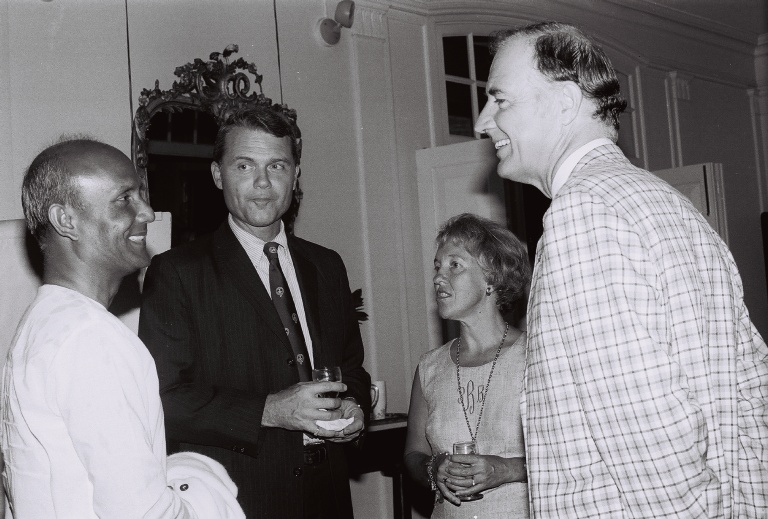
0216920-R5-E014-1977-08-10aug-sri-chinmoy-with-Alfred-Sunder-wainwright-house-others-at-Prog-honour-original-med-room-at-un
(L to R) Sri Chinmoy. Mr. John Ballard , President of the Laymen’s Movement and Wainwright House; (Mrs B? or unidentified woman ) ;Dr. Alfred Sunderwirth, Executive Director of the Laymen’s Movement and Wainwright House:
================================================
Gallery 1:
- 1977-08-10-09-sri-chinmoy-and-robert-muller-by-med-room-furnishings-in-wainwright-house-
- 1977-08-10aug-rye-ny-med-room-un-after-event-wainwright-house-Sri-Chinmoy-Robert-Muller.jp
- 1977-08-10aug-rye-ny-med-room-un-Weyman-C-Huckabee-Laymen’s-Movement-Executive-Dir-1941-1969
- 1977-08-10-15-crp
- 1977-08-10-wainwrigth-house-Sri-Chinmoy-in room-with-furnishings-from-original -meditation-room-at-un-reading-plaque
- 1977-08-10-wainwrigth-house-Sri-Chinmoy-in room-with-furnishings-from-original -meditation-room-at-un
- 1977-08-10aug-rye-ny-med-room-un-after-event-wainwright-house-crp-01
- 1977-08-10aug-rye-ny-med-room-un-after-event-wainwright-house-crp-02
- 1977-08-10aug-rye-ny-med-room-un-after-event-wainwright-house-Sri-Chinmoy-Mr-and-Mrs-Muller
- 1977-08-10aug-rye-ny-med-room-un-sri-chinmoy-observes-Alfred-Sunderwirth-speaks
- 1977-08-10aug-rye-ny-med-room-un-mr-mrs-huckabbe-and-congratulating-friends
- 977-08-10aug-rye-ny-med-room-un-sri-chinmoy-observes-r-muller-speak-scaled.
- 0216920-R5-E011-08-aug-1977-r-muller-speak-rye-ny-sri-chinmoy-beside.
- 977-08-10aug-rye-ny-med-room-un-sri-chinmoy-observes-F-carpenter-speak-2
- 1977-08-10-13-sri-chinmoy-mrs-muller-smiles-rye-ny-wainwright-house-scaled
- 1977-08-10-13-sri-chinmoy-altred-sunderwirth-john-ballard-rye-ny-wainwright-house-
- 1977-08-10-13-sri-chinmoy-john-ballard-speaks-rye-ny-wainwright-house.j
- 1977-08-10-13-sri-chinmoy-mrs-mr-muller-rye-ny-wainwright-house-scaled.jpg June 25, 2020
- 1977-08-10-13-sri-chinmoy-mrs-muller-smiles-r-muller-observes-rye-ny-wainwright-house
- 1977-08-10-14-sri-chinmoy-in-room-orig-un-med-furrnishing-alter-examins-small-plaque.
- 1977-08-10-14-sri-chinmoy-in-room-orig-un-med-furrnishing-alter-small-plaque-left-
- 1977-08-10-14-sri-chinmoy-in-room-orig-un-med-furrnishing-alter-small-plaque-left-crp-
- 1977-08-10-14-sri-chinmoy-in-room-orig-un-med-furrnishing-alter-small-plaque-right-scaled.jpg
- 1977-08-10aug-rye-ny-furnishings-from-orig-unmed-room-wainwright-house-sri-chinmoy-plays-esraj
- 1977-08-10aug-rye-ny-med-room-un-r-mwller-mr-mrs-huckabbe-holding-small-bust-crp-scaled.j
Gallery: 2
Gallery: Excerpt from “Meditation at he UN” Aug 1977
- pmaun-rpt-1977_Page_20-641
- pmaun-rpt-1977_Page_19-642
- bu-scpmaun-1977-08-27-vol-05-n-08-aug_Page_07
- bu-scpmaun-1977-08-27-vol-05-n-08-aug_Page_08
- bu-scpmaun-1977-08-27-vol-05-n-08-aug_Page_08-orig-med-room
See also :
Introduction: UN Meditation – Room of Quiet – Link to History
A. 20th Anniversary since redesign of Meditation Room 15 Nov 1977
B. Excerpts on History of meditation Room – Wainwright House, Aug 10 1977
C. Extended remarks from 10 Aug 1977 – more history on UN Meditation Room
- 1977-08-10-wainwrigth-house-Sri-Chinmoy-in room-with-furnishings-from-original -meditation-room-at-un
- 1977-08-10-wainwrigth-house-Sri-Chinmoy-in room-with-furnishings-from-original -meditation-room-at-un-reading-plaque
- (c) Copyrights Sri Chinmoy Centre
- (L to R) Sri Chinmoy. Mr. John Ballard , President of the Laymen’s Movement and Wainwright House; (Mrs unidentified woman ) ;Dr. Alfred Sunderwirth, Executive Director of the Laymen’s Movement and Wainwright House:
- (L to R) Mr. John Ballard , President of the Laymen’s Movement and Wainwright House; Dr. Alfred Sunderwirth, Executive Director of the Laymen’s Movement and Wainwright House; Sri Chinmoy.:
- (c) Copyrights Sri Chinmoy Centre
- (c) Copyrights Sri Chinmoy Centre
- (c) Copyrights Sri Chinmoy Centre
- (c) Copyrights Sri Chinmoy Centre
- (c) Copyrights Sri Chinmoy Centre
- (c) Copyrights Sri Chinmoy Centre
- 1977-08-10-15-crp
- 1977-08-10-wainwrigth-house-Sri-Chinmoy-in room-with-furnishings-from-original -meditation-room-at-un
- (c) Copyrights Sri Chinmoy Centre
- (c) Copyrights Sri Chinmoy Centre
